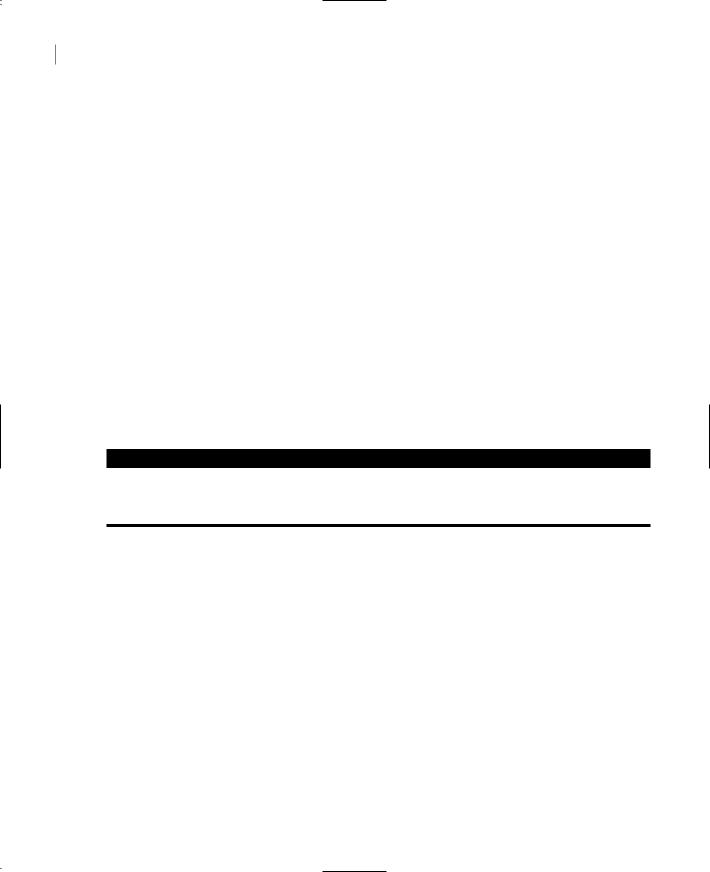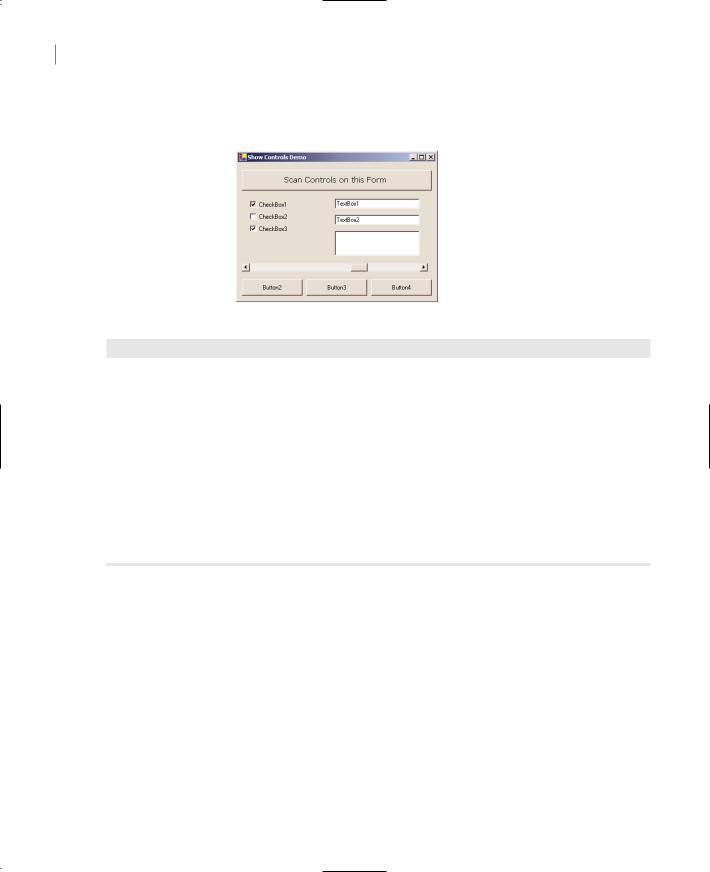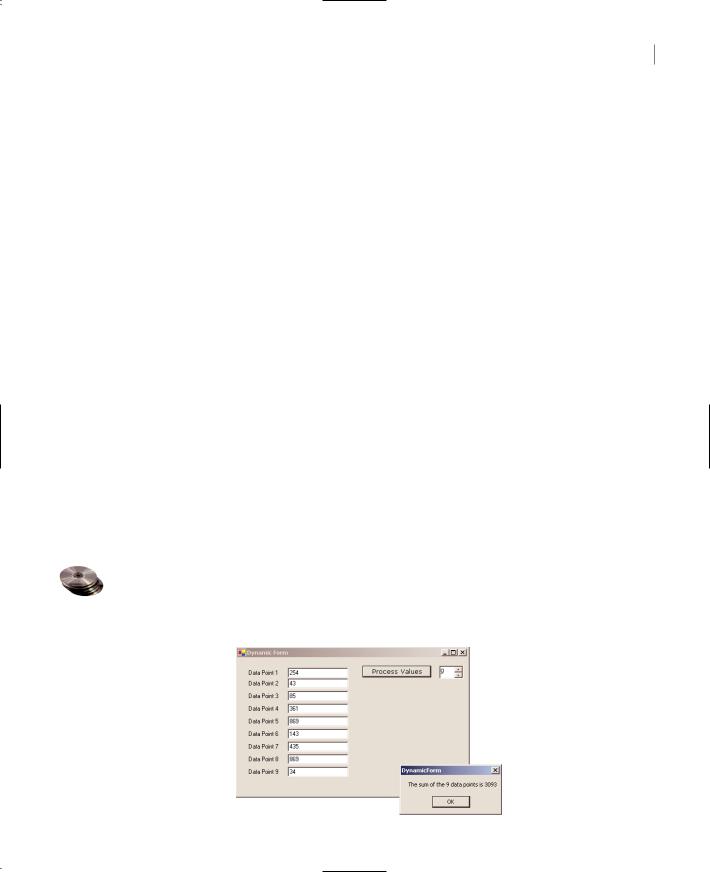
- •Using Your Sybex Electronic Book
- •Acknowledgments
- •Contents at a Glance
- •Introduction
- •Who Should Read This Book?
- •How About the Advanced Topics?
- •The Structure of the Book
- •How to Reach the Author
- •The Integrated Development Environment
- •The Start Page
- •Project Types
- •Your First VB Application
- •Making the Application More Robust
- •Making the Application More User-Friendly
- •The IDE Components
- •The IDE Menu
- •The Toolbox Window
- •The Solution Explorer
- •The Properties Window
- •The Output Window
- •The Command Window
- •The Task List Window
- •Environment Options
- •A Few Common Properties
- •A Few Common Events
- •A Few Common Methods
- •Building a Console Application
- •Summary
- •Building a Loan Calculator
- •How the Loan Application Works
- •Designing the User Interface
- •Programming the Loan Application
- •Validating the Data
- •Building a Math Calculator
- •Designing the User Interface
- •Programming the MathCalculator App
- •Adding More Features
- •Exception Handling
- •Taking the LoanCalculator to the Web
- •Working with Multiple Forms
- •Working with Multiple Projects
- •Executable Files
- •Distributing an Application
- •VB.NET at Work: Creating a Windows Installer
- •Finishing the Windows Installer
- •Running the Windows Installer
- •Verifying the Installation
- •Summary
- •Variables
- •Declaring Variables
- •Types of Variables
- •Converting Variable Types
- •User-Defined Data Types
- •Examining Variable Types
- •Why Declare Variables?
- •A Variable’s Scope
- •The Lifetime of a Variable
- •Constants
- •Arrays
- •Declaring Arrays
- •Initializing Arrays
- •Array Limits
- •Multidimensional Arrays
- •Dynamic Arrays
- •Arrays of Arrays
- •Variables as Objects
- •So, What’s an Object?
- •Formatting Numbers
- •Formatting Dates
- •Flow-Control Statements
- •Test Structures
- •Loop Structures
- •Nested Control Structures
- •The Exit Statement
- •Summary
- •Modular Coding
- •Subroutines
- •Functions
- •Arguments
- •Argument-Passing Mechanisms
- •Event-Handler Arguments
- •Passing an Unknown Number of Arguments
- •Named Arguments
- •More Types of Function Return Values
- •Overloading Functions
- •Summary
- •The Appearance of Forms
- •Properties of the Form Control
- •Placing Controls on Forms
- •Setting the TabOrder
- •VB.NET at Work: The Contacts Project
- •Anchoring and Docking
- •Loading and Showing Forms
- •The Startup Form
- •Controlling One Form from within Another
- •Forms vs. Dialog Boxes
- •VB.NET at Work: The MultipleForms Project
- •Designing Menus
- •The Menu Editor
- •Manipulating Menus at Runtime
- •Building Dynamic Forms at Runtime
- •The Form.Controls Collection
- •VB.NET at Work: The DynamicForm Project
- •Creating Event Handlers at Runtime
- •Summary
- •The TextBox Control
- •Basic Properties
- •Text-Manipulation Properties
- •Text-Selection Properties
- •Text-Selection Methods
- •Undoing Edits
- •VB.NET at Work: The TextPad Project
- •Capturing Keystrokes
- •The ListBox, CheckedListBox, and ComboBox Controls
- •Basic Properties
- •The Items Collection
- •VB.NET at Work: The ListDemo Project
- •Searching
- •The ComboBox Control
- •The ScrollBar and TrackBar Controls
- •The ScrollBar Control
- •The TrackBar Control
- •Summary
- •The Common Dialog Controls
- •Using the Common Dialog Controls
- •The Color Dialog Box
- •The Font Dialog Box
- •The Open and Save As Dialog Boxes
- •The Print Dialog Box
- •The RichTextBox Control
- •The RTF Language
- •Methods
- •Advanced Editing Features
- •Cutting and Pasting
- •Searching in a RichTextBox Control
- •Formatting URLs
- •VB.NET at Work: The RTFPad Project
- •Summary
- •What Is a Class?
- •Building the Minimal Class
- •Adding Code to the Minimal Class
- •Property Procedures
- •Customizing Default Members
- •Custom Enumerations
- •Using the SimpleClass in Other Projects
- •Firing Events
- •Shared Properties
- •Parsing a Filename String
- •Reusing the StringTools Class
- •Encapsulation and Abstraction
- •Inheritance
- •Inheriting Existing Classes
- •Polymorphism
- •The Shape Class
- •Object Constructors and Destructors
- •Instance and Shared Methods
- •Who Can Inherit What?
- •Parent Class Keywords
- •Derived Class Keyword
- •Parent Class Member Keywords
- •Derived Class Member Keyword
- •MyBase and MyClass
- •Summary
- •On Designing Windows Controls
- •Enhancing Existing Controls
- •Building the FocusedTextBox Control
- •Building Compound Controls
- •VB.NET at Work: The ColorEdit Control
- •VB.NET at Work: The Label3D Control
- •Raising Events
- •Using the Custom Control in Other Projects
- •VB.NET at Work: The Alarm Control
- •Designing Irregularly Shaped Controls
- •Designing Owner-Drawn Menus
- •Designing Owner-Drawn ListBox Controls
- •Using ActiveX Controls
- •Summary
- •Programming Word
- •Objects That Represent Text
- •The Documents Collection and the Document Object
- •Spell-Checking Documents
- •Programming Excel
- •The Worksheets Collection and the Worksheet Object
- •The Range Object
- •Using Excel as a Math Parser
- •Programming Outlook
- •Retrieving Information
- •Recursive Scanning of the Contacts Folder
- •Summary
- •Advanced Array Topics
- •Sorting Arrays
- •Searching Arrays
- •Other Array Operations
- •Array Limitations
- •The ArrayList Collection
- •Creating an ArrayList
- •Adding and Removing Items
- •The HashTable Collection
- •VB.NET at Work: The WordFrequencies Project
- •The SortedList Class
- •The IEnumerator and IComparer Interfaces
- •Enumerating Collections
- •Custom Sorting
- •Custom Sorting of a SortedList
- •The Serialization Class
- •Serializing Individual Objects
- •Serializing a Collection
- •Deserializing Objects
- •Summary
- •Handling Strings and Characters
- •The Char Class
- •The String Class
- •The StringBuilder Class
- •VB.NET at Work: The StringReversal Project
- •VB.NET at Work: The CountWords Project
- •Handling Dates
- •The DateTime Class
- •The TimeSpan Class
- •VB.NET at Work: Timing Operations
- •Summary
- •Accessing Folders and Files
- •The Directory Class
- •The File Class
- •The DirectoryInfo Class
- •The FileInfo Class
- •The Path Class
- •VB.NET at Work: The CustomExplorer Project
- •Accessing Files
- •The FileStream Object
- •The StreamWriter Object
- •The StreamReader Object
- •Sending Data to a File
- •The BinaryWriter Object
- •The BinaryReader Object
- •VB.NET at Work: The RecordSave Project
- •The FileSystemWatcher Component
- •Properties
- •Events
- •VB.NET at Work: The FileSystemWatcher Project
- •Summary
- •Displaying Images
- •The Image Object
- •Exchanging Images through the Clipboard
- •Drawing with GDI+
- •The Basic Drawing Objects
- •Drawing Shapes
- •Drawing Methods
- •Gradients
- •Coordinate Transformations
- •Specifying Transformations
- •VB.NET at Work: Plotting Functions
- •Bitmaps
- •Specifying Colors
- •Defining Colors
- •Processing Bitmaps
- •Summary
- •The Printing Objects
- •PrintDocument
- •PrintDialog
- •PageSetupDialog
- •PrintPreviewDialog
- •PrintPreviewControl
- •Printer and Page Properties
- •Page Geometry
- •Printing Examples
- •Printing Tabular Data
- •Printing Plain Text
- •Printing Bitmaps
- •Using the PrintPreviewControl
- •Summary
- •Examining the Advanced Controls
- •How Tree Structures Work
- •The ImageList Control
- •The TreeView Control
- •Adding New Items at Design Time
- •Adding New Items at Runtime
- •Assigning Images to Nodes
- •Scanning the TreeView Control
- •The ListView Control
- •The Columns Collection
- •The ListItem Object
- •The Items Collection
- •The SubItems Collection
- •Summary
- •Types of Errors
- •Design-Time Errors
- •Runtime Errors
- •Logic Errors
- •Exceptions and Structured Exception Handling
- •Studying an Exception
- •Getting a Handle on this Exception
- •Finally (!)
- •Customizing Exception Handling
- •Throwing Your Own Exceptions
- •Debugging
- •Breakpoints
- •Stepping Through
- •The Local and Watch Windows
- •Summary
- •Basic Concepts
- •Recursion in Real Life
- •A Simple Example
- •Recursion by Mistake
- •Scanning Folders Recursively
- •Describing a Recursive Procedure
- •Translating the Description to Code
- •The Stack Mechanism
- •Stack Defined
- •Recursive Programming and the Stack
- •Passing Arguments through the Stack
- •Special Issues in Recursive Programming
- •Knowing When to Use Recursive Programming
- •Summary
- •MDI Applications: The Basics
- •Building an MDI Application
- •Built-In Capabilities of MDI Applications
- •Accessing Child Forms
- •Ending an MDI Application
- •A Scrollable PictureBox
- •Summary
- •What Is a Database?
- •Relational Databases
- •Exploring the Northwind Database
- •Exploring the Pubs Database
- •Understanding Relations
- •The Server Explorer
- •Working with Tables
- •Relationships, Indices, and Constraints
- •Structured Query Language
- •Executing SQL Statements
- •Selection Queries
- •Calculated Fields
- •SQL Joins
- •Action Queries
- •The Query Builder
- •The Query Builder Interface
- •SQL at Work: Calculating Sums
- •SQL at Work: Counting Rows
- •Limiting the Selection
- •Parameterized Queries
- •Calculated Columns
- •Specifying Left, Right, and Inner Joins
- •Stored Procedures
- •Summary
- •How About XML?
- •Creating a DataSet
- •The DataGrid Control
- •Data Binding
- •VB.NET at Work: The ViewEditCustomers Project
- •Binding Complex Controls
- •Programming the DataAdapter Object
- •The Command Objects
- •The Command and DataReader Objects
- •VB.NET at Work: The DataReader Project
- •VB.NET at Work: The StoredProcedure Project
- •Summary
- •The Structure of a DataSet
- •Navigating the Tables of a DataSet
- •Updating DataSets
- •The DataForm Wizard
- •Handling Identity Fields
- •Transactions
- •Performing Update Operations
- •Updating Tables Manually
- •Building and Using Custom DataSets
- •Summary
- •An HTML Primer
- •HTML Code Elements
- •Server-Client Interaction
- •The Structure of HTML Documents
- •URLs and Hyperlinks
- •The Basic HTML Tags
- •Inserting Graphics
- •Tables
- •Forms and Controls
- •Processing Requests on the Server
- •Building a Web Application
- •Interacting with a Web Application
- •Maintaining State
- •The Web Controls
- •The ASP.NET Objects
- •The Page Object
- •The Response Object
- •The Request Object
- •The Server Object
- •Using Cookies
- •Handling Multiple Forms in Web Applications
- •Summary
- •The Data-Bound Web Controls
- •Simple Data Binding
- •Binding to DataSets
- •Is It a Grid, or a Table?
- •Getting Orders on the Web
- •The Forms of the ProductSearch Application
- •Paging Large DataSets
- •Customizing the Appearance of the DataGrid Control
- •Programming the Select Button
- •Summary
- •How to Serve the Web
- •Building a Web Service
- •Consuming the Web Service
- •Maintaining State in Web Services
- •A Data-Driven Web Service
- •Consuming the Products Web Service in VB
- •Summary

232 Chapter 5 WORKING WITH FORMS
Building Dynamic Forms at Runtime
There are situations when you won’t know in advance how many instances of a given control may be required on a form. This isn’t very common, but if you’re writing a data-entry application and you want to work with many tables of a database, you’ll have to be especially creative. Since every table consists of different fields, it will be difficult to build a single form to accommodate all the possible tables a user may throw at your application.
Another good reason for adding or removing controls at runtime is to enable certain features of your application, depending on the current state or the user’s privileges. For these situations, it is possible to design dynamic forms, which are populated at runtime. The simplest approach is to create more controls than you’ll ever need and set their Visible property to False at design time. At runtime, you can display the controls by switching their Visible property to True. As you know already, quick-and-dirty methods are not the most efficient ones. You must still rearrange the controls on the form to make it look nice at all times. The proper method to create dynamic forms at runtime is to add and remove controls with the techniques discussed in this section.
Just as you can create new instances of forms, you can also create new instances of any control and place them on a form. The Form object exposes the Controls collection, which contains all the controls on the form. This collection is created automatically as you place controls on the form at design time, and you can access the members of this collection from within your code. It is also possible to add new members to the collection, or remove existing members, with the Add and Remove statements accordingly.
VB6 VB.NET
VB.NET doesn’t support arrays of controls, which used to be the simplest method of adding new controls on a form at runtime. With VB.NET, you must create a new instance of a control, set its properties, and then place it on the form by adding it to the form’s Controls collection.
The Form.Controls Collection
To understand how to create controls at runtime and place them on a form, you must first learn about the Controls collection. All the controls on a form are members of the Controls property, which is a collection. The Controls collection exposes members for accessing and manipulating the controls at runtime, and these members are:
Add method Adds a new element to the Controls collection. In effect, it adds a new control on the current form. The Add method accepts a control as argument and adds it to the collection. Its syntax is:
Controls.Add(controlObj)
where controlObj is an instance of a control. To place a new Button control on the form, declare a variable of the Button type, set its properties, and then add it to the Controls collection:
Dim bttn As New System.WinForms.Button
Copyright ©2002 SYBEX, Inc., Alameda, CA |
www.sybex.com |

BUILDING DYNAMIC FORMS AT RUNTIME 233
bttn.Text = “New Button” bttn.Left = 100 bttn.Top = 60 bttn.Width = 80 Me.Controls.Add(bttn)
Remove method Removes an element from the Controls collection. It accepts as argument either the index of the control to be removed, or a reference to the control to be removed (a variable of the Control type that represents one of the controls on the form). The syntax of these two forms is:
Me.Controls.Remove(index)
Me.Controls.Remove(controlObj)
Count property Returns the number of elements in the Controls collection. The number of controls on the current form is given by the expression Me.Controls.Count. Notice that if there are container controls, the controls in the containers are not included in the count. For example, if your form contains a Panel control, the controls on the panel won’t be included in the value returned by the Count property.
All method Returns all the controls on a form (or in a container control) as an array of the System.WinForms.Control type. You can iterate through the elements of this array with the usual methods exposed by the Array class.
Clear method Removes all the elements of the Controls array.
The Controls collection is also a property of any control that can host other controls. Most of the controls that come with VB.NET can host other controls. The Panel control, for example, is a container for other controls. As you recall from our discussion of the Anchor and Dock properties, it’s customary to place controls on a panel and handle them collectively, as a section of the form.
They are moved along with the panel at design time, and they’re rearranged as a group at runtime. The panel belongs to the form’s Controls collection. The element that corresponds to the Panel control provides its own Controls collection, which lets you access the controls on the panel.
If a panel is the third element of the Controls collection, you can access it with the expression Me.Controls(2). To access the controls on this panel, use the following Controls collection:
Me.Controls(2).Controls
VB.NET at Work: The ShowControls Project
The ShowControls project (Figure 5.24) demonstrates the basic methods of the Controls array. Open the project and add any number of controls on its main form. You can place a panel to act as a container for other controls as well. Just don’t remove the button at the top of the form (the Scan Controls On This Form button), which contains the code to list all the controls.
The code behind the Scan Controls On This Form button enumerates the elements of the form’s Controls collection. The code doesn’t take into consideration containers within containers. This would require a recursive routine, which would scan for controls at any depth. You will read a lot about recursive routines in this book and you will find a tutorial on the topic in Chapter 18. After you’re familiar with recursion (if you aren’t already), you can revisit this project and adjust its code
Copyright ©2002 SYBEX, Inc., Alameda, CA |
www.sybex.com |

234 Chapter 5 WORKING WITH FORMS
accordingly. The code that iterates through the form’s Controls collection and prints the names of the controls in the Output window is shown in Listing 5.14.
Figure 5.24
Accessing the controls on a form at runtime
Listing 5.14: Iterating the Controls Collection
Private Sub Button1_Click(ByVal sender As System.Object, _
ByVal e As System.EventArgs) Handles Button1.Click
Dim i As Integer
For i = 0 To Me.Controls.Count - 1
Console.WriteLine(Me.Controls(i).ToString)
If Me.Controls(i).GetType Is GetType(system.Windows.Forms.Panel) Then
Dim j As Integer
For j = 0 To Me.Controls(i).Controls.Count - 1
Console.WriteLine(Me.Controls(i).Controls(j).ToString)
Next
End If
Next
End Sub
The form shown in Figure 5.24 produced the following output:
System.Windows.Forms.HScrollBar, Minimum: 0, Maximum: 100, Value: 60
System.Windows.Forms.CheckedListBox
System.Windows.Forms.TextBox, Text: TextBox2
System.Windows.Forms.CheckBox, CheckState: 1
System.Windows.Forms.CheckBox, CheckState: 0
System.Windows.Forms.CheckBox, CheckState: 1
System.Windows.Forms.TextBox, Text: TextBox1
System.Windows.Forms.Button, Text: Button4
System.Windows.Forms.Button, Text: Button3
System.Windows.Forms.Button, Text: Button2
Each member of the Controls collection exposes the GetType method, which returns the control’s type, so that you can know what control is stored in each collection element. To compare the control’s type returned by the GetType method, use the GetType() function passing as argument a
Copyright ©2002 SYBEX, Inc., Alameda, CA |
www.sybex.com |

BUILDING DYNAMIC FORMS AT RUNTIME 235
control type. The following statement examines whether the control in the first element of the Controls collection is a TextBox:
If Me.Controls(0).GetType Is GetType(system.WinForms.TextBox) Then MsgBox(“It’s a TextBox control”)
End If
Notice the use of the Is operator in the preceding statement. The equals operator will cause an exception, because objects can be compared only with the Is operator. Do not use string comparisons to find out the control’s type. A statement like the following won’t work:
If Me.Controls(i).GetType = “TextBox” Then ... ‘ WRONG
The elements of the Controls collection are of the Control type, and they expose the properties of the control they represent. Their Top and Left properties read (or set) the position of the corresponding control on the form. The following expressions move the first control on the form to the specified location:
Me.Controls(0).Top = 10
Me.Controls(0).Left = 40
To access other properties of the control represented by an element of the Controls collection, you must first cast it to the appropriate type. If the first control of the collection is a TextBox control, use the CType() function to cast it to a TextBox variable, and then request its Text property:
If Me.Controls(i).GetType Is GetType(system.WinForms.TextBox) Then
Console.WriteLine(CType(Me.Controls(0), TextBox).Text)
End If
The If statement is necessary, unless you can be sure that the first control is a TextBox control. If you omit the If statement and attempt to convert it to a TextBox, a runtime exception will be thrown if the object Me.Controls(0) isn’t a TextBox control.
VB.NET at Work: The DynamicForm Project
To demonstrate how to handle controls at runtime from within your code, I’ve included the DynamicForm project (Figure 5.25), a simple data-entry window for a small number of data points. The user can specify at runtime the number of data points they wish to enter, and the number of TextBoxes on the control changes.
Figure 5.25
The DynamicForm project
Copyright ©2002 SYBEX, Inc., Alameda, CA |
www.sybex.com |

236 Chapter 5 WORKING WITH FORMS
The control you see at the top of the form is the NumericUpDown control. All you really need to know about this control is that it fires the ValueChanged event every time the user clicks one of the two arrows or types another value in its edit area. This event handler’s code adds or removes controls on the form, so that the number of TextBoxes (as well as the number of the corresponding labels) matches the value on the control. Listing 5.15 shows the handler for the ValueChanged event of the NumericUpDown1 control. The ValueChanged event is fired when the user clicks one of the two arrows on the control or types a new value in the control’s edit area.
Listing 5.15: Adding and Removing Controls at Runtime
Private Sub NumericUpDown1_ValueChanged(ByVal sender As System.Object, _
ByVal e As System.EventArgs) Handles NumericUpDown1.ValueChanged Dim TB As New TextBox()
Dim LBL As New Label() Dim i, TBoxes As Integer
‘Count all TextBox controls on the form For i = 0 To Me.Controls.Count - 1
If Me.Controls(i).GetType Is GetType(System.Windows.Forms.TextBox) Then TBoxes = TBoxes + 1
End If Next
‘Add new controls if number of controls on the form is less
‘than the number specified with the NumericUpDown control
If TBoxes < NumericUpDown1.Value Then
TB.Left = 100
TB.Width = 120
TB.Text = “”
For i = TBoxes To NumericUpDown1.Value - 1
TB = New TextBox()
LBL = New Label()
If NumericUpDown1.Value = 1 Then
TB.Top = 20
Else
TB.Top = Me.Controls(Me.Controls.Count - 2).Top + 25
End If
Me.Controls.Add(TB)
LBL.Left = 20
LBL.Width = 80
LBL.Text = “Data Point “ & i
LBL.Top = TB.Top + 3
TB.Left = 100
TB.Width = 120
TB.Text = “”
Me.Controls.Add(LBL)
AddHandler TB.Enter, _
New System.EventHandler(AddressOf TBox_Enter)
AddHandler TB.Leave, _
New System.EventHandler(AddressOf TBox_Leave)
Copyright ©2002 SYBEX, Inc., Alameda, CA |
www.sybex.com |

BUILDING DYNAMIC FORMS AT RUNTIME 237
Next
Else
For i = Me.Controls.Count - 1 To _
Me.Controls.Count - 2 * (TBoxes - NumericUpDown1.Value) Step -2
Me.Controls.Remove(Controls(i))
Me.Controls.Remove(Controls(i - 1))
Next
End If
End Sub
First, the code counts the number of TextBoxes on the form, then it figures out whether it should add or remove elements from the Controls collection. To remove controls, the code iterates through the last n controls on the form and removes them. The number of controls to be removed, n, is:
2 * (TBoxes - NumericUpDown1.Value)
where TBoxes is the total number of controls on the form minus the value specified in the NumericUpDown control.
If the value entered in the NumericUpDown control is less than the number of TextBox controls on the form, the code removes the excess controls from within a loop. At each step, it removes two controls, one of them being a TextBox and the other being a Label control with the matching caption (that’s why the loop variable is decreased by two). The code also assumes that the first two controls on the form are the Button and the NumericUpDown controls. If the value entered by the user exceeds the number of TextBox controls on the form, the code adds the necessary pairs of TextBox and Label controls to the form.
To add controls, the code initializes a TextBox (TB) and a Label (LBL) variable. Then, its sets their locations and the label’s caption. The left coordinate of all labels is 20, their width is 80, and their Text property (the label’s caption) is the order of the data item. The vertical coordinate is 20 pixels for the first control, and all other controls are three pixels below the control on the previous row. Once a new control has been set up, it’s added to the Controls collection with one of the following statements:
Me.Controls.Add(TB) |
‘ |
adds |
a |
TextBox control |
Me.Controls.Add(LBL) |
‘ |
adds |
a |
Label control |
The code contains a few long lines, but it isn’t really complicated. It’s based on the assumption that, except for the first few controls on the form, all others are pairs of Label and TextBox controls used for data entry.
To use the values entered by the user on the dynamic form, we must iterate the Controls collection, extract the values in the TextBox controls and use them. Listing 5.16 shows how the Process Values button scans the TextBox controls on the form performs some very basic calculations with them (counting the number of data points and summing their values).
Listing 5.16: Reading the Controls on the Form
Private Sub Button1_Click(ByVal sender As System.Object, _
ByVal e As System.EventArgs) Handles Button1.Click
Dim ctrl As Object
Copyright ©2002 SYBEX, Inc., Alameda, CA |
www.sybex.com |

238 Chapter 5 WORKING WITH FORMS
Dim Sum As Double = 0, points As Integer = 0 Dim iCtrl As Integer
For iCtrl = 0 To Me.Controls.Count - 1 ctrl = Me.Controls(iCtrl)
If ctrl.GetType Is GetType(system.Windows.Forms.TextBox) Then If IsNumeric(CType(ctrl, TextBox).Text) Then
Sum = Sum + CType(ctrl, TextBox).Text points = points + 1
End If End If
Next
MsgBox(“The sum of the “ & points.ToString & “ data points is “ & _ Sum.ToString)
End Sub
You can add more statements to calculate the mean and other vital statistics, or process the values in any other way. You can even dump all the values into an array and then use the array notation to manipulate them.
You can also write a For Each…Next loop to iterate through the TextBox controls on the form, as shown in Listing 5.17. The Process Values button at the bottom of the form demonstrates this alternate method of iterating through the elements of the Me.Controls collection. Because this loop goes through all the elements, we must examine the type of each control in the loop and process only the TextBox controls.
Listing 15.17: Reading the Controls with a For Each…Next Loop
Private Sub bttnProcess2_Click(ByVal sender As System.Object, _
ByVal e As System.EventArgs) Handles bttnProcess2.Click Dim TB As Control
Dim Sum As Double = 0, points As Integer = 0 For Each TB In Me.Controls
If TB.GetType Is GetType(Windows.Forms.TextBox) Then If IsNumeric(CType(TB, TextBox).Text) Then
Sum = Sum + CType(TB, TextBox).Text points = points + 1
End If End If
Next
MsgBox(“The sum of the “ & points.ToString & “ data points is “ & _ Sum.ToString)
End Sub
Copyright ©2002 SYBEX, Inc., Alameda, CA |
www.sybex.com |
